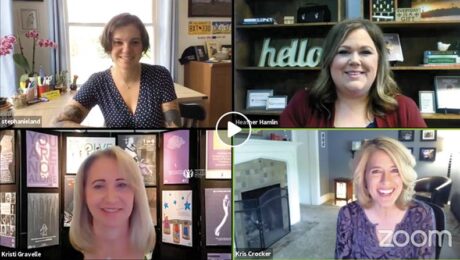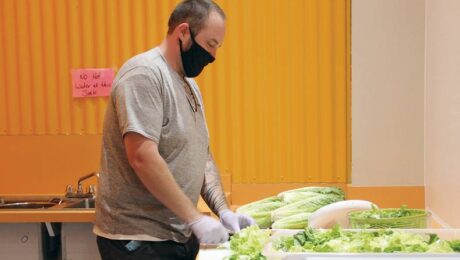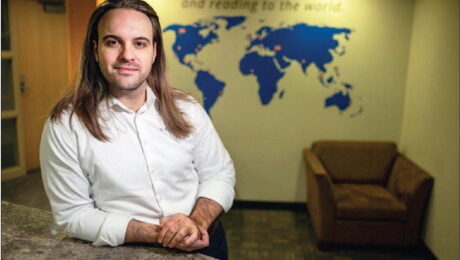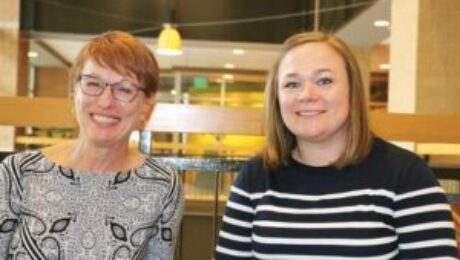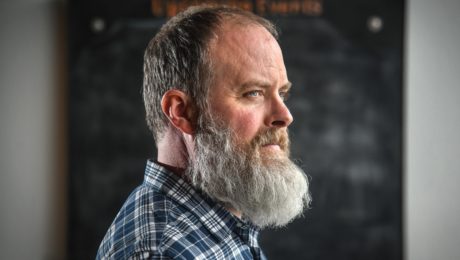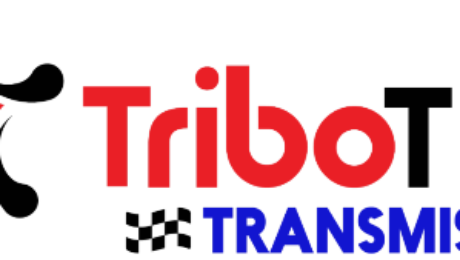Article first appeared in Spokane Business Journal, July 30 2020. Written by Virginia Thomas
Socially distanced, socially conscious
Some nonprofits switch to longer fundraising cycles, spend less on overhead
Instead of canceling fundraising events, many Inland Northwest nonprofits have moved them into the digital realm.
Donor participation in charity events is lower, but some nonprofits say they’re receiving nearly as many donations as in prior years from a smaller pool of donors, and nonprofits are saving money by forgoing costly in-person events in favor of low-cost online affairs.
Heather Hamlin, executive director of Women Helping Women Fund, says her staff saw the writing on the wall by mid-March. The organization had planned its 28th annual luncheon for May, but Hamlin and her staff knew well before then that in-person events wouldn’t be possible for several months, at least.
“But the need in the community was bigger than ever,” Hamlin says. “We saw that was going to continue to grow, so we decided to move to a virtual event.”
Women Helping Women Fund decided to change to a longer, eight-week fundraising campaign in which table captains set goals for their groups, who raised money through networking. Keynote speaker Stephanie Land spoke to the organization through a Facebook Live event, which Hamlin says has garnered more than 13,000 views.
Hamlin says Women Helping Women Fund received about $170,000 in private donations in its eight-week campaign, as opposed to the $300,000 the annual luncheon typically generates. Hamlin says corporate donations go to underwriting the event, so Women Helping Women Fund receives every dollar donated by individual donors.
Lutheran Community Services Northwest’s fundraiser was a different story. The annual 8 Lakes Leg Aches bike ride fundraiser, which typically results in about $75,000 in donations, raised about $80,000 in this year’s “virtual ride.”

Clockwise from top left, Stephanie Land, Heather Hamlin, Kris Crocker, and Kristi Gravelle participate in Women Helping Women Fund’s virtual event.
The 22nd annual biking event had been scheduled for June 22 but was rescheduled for July 18. Development manager Christie McKee says the organization had thought an in-person event might be possible. By July, it was clear that wouldn’t happen, and the organization decided to make 8 Lakes Leg Aches a virtual event.
Attendees were invited to complete one of three rides, with routes that were 30, 45, and 70 miles long, on the course of their choice, or even on a stationary bike, between July 11 and July 18. A finish-line event was held via Facebook Live on July 18.
McKee says ridership was down this year, to about 200 participants from nearly 600 riders in past years, but she says she was impressed by the support those 200 riders provided to the organization.
“We had one pledge rider who raised $9,900 who is 90 years old and rode 17 miles to celebrate his 90th birthday,” McKee says. “We had a few others who were able to raise $10,000 each, and several that did $3,000 or more.”
McKee says most riders are from outside of the Spokane area, which was part of the reason for encouraging participants to bike any course. But it also meant that overhead for the fundraiser was much lower.
“Usually, if we have David’s Pizza at the event and we have 600 riders, our bill’s going to be for 600 riders,” McKee says. “We have roughly 160 riders who are here in this area. The others are all out of town, so they’re not even going to go to David’s Pizza.”
McKee also ordered about half as many T-shirts as usual for the event, expecting that participation would be lower.
“We’ll actually net more this year, because our expenses are going to be lower,” McKee says.
Amy Knapton Vega, executive director at Vanessa Behan Crisis Nursery, said that when she was trying to decide how to pivot the organization’s annual June benefit luncheon, she was told by some that the organization shouldn’t expect to raise any money from events.
But Vega watched as other organizations held successful fundraising events, and she decided to forge ahead. She asked for help from longtime partner Hamilton Studios, which helped the organization put together a virtual benefit luncheon.
“They helped us navigate through what would work, how to tailor it, and they did a great job of doing their own set up, as far as social distancing,” Vega says.
The online event drew 300 viewers, in comparison to the roughly 1,000 people who usually attend the luncheon. But Vega says the exceeded its goal of $170,000, bringing in a total of $172,000.
Going virtual saved Vanessa Behan Crisis Nursery thousands of dollars. Vega says the luncheon usually costs the organization about $40,000. This year, the crisis nursery spent less than $5,000 for its online event.
Don Hamilton, owner of Hamilton Studios, says he started adapting his video production and photography studio into a socially distanced, livestream-capable studio in March. A friend was scheduled to deliver a lecture to a college in Virginia in late March and decided to do so via Zoom. Hamilton thought his friend deserved better than a bland setting.
“It got me wondering — how could I use my cameras, lights, mics, and large studio to safely offer my friend a high-production-value presentation?” Hamilton says. “I started looking into the technology to adapt my motion picture production equipment to support a multicamera, livestreaming studio.”
Hamilton asked the Spokane Regional MarCom Association if he could handle the nonprofit organization’s annual Spark awards event to prove he could do a hybrid virtual event that combined livestreaming with pre-recorded segments.
“They were game, so we started by producing a glossy teaser announcing the event,” Hamilton says. “We then had a number of members of the MarCom board come in, one at a time, to pre-record announcements of the winners.”
Hamilton says the event was a success.
“The show moved seamlessly between pre-recorded packages and the live hosts reading a script from a large studio teleprompter,” he says.
Since then, Hamilton Studios has handled five livestreaming events, including the Vanessa Behan luncheon and YWCA Spokane’s “An Evening in Tuscany” fundraising event.
Social distancing at Hamilton Studio is easy, he says. His studio is located in the former auditorium of St. Joseph Catholic School, and he’s divided the basketball court in half.
“The idea is that whatever we do in there, we get one half-court for the crew and one half-court for the talent, so that nobody’s ever closer than 15 feet,” Hamilton says.
Hamilton says no more than seven people are in the studio at any one time. When a livestreaming event is taking place, just three crew members run the show: Hamilton and his wife, Lorna, sit together at the master controls, where Lorna manages the teleprompter, and Hamilton manages four live cameras in addition to pre-recorded videos. About 25 feet away from master controls, video editor Hannah Sander becomes the live program manager during livestreaming events.
Hamilton says he believes it will be at least another two years before nonprofits can return safely to holding in-person events. In that time, he expects demand for hybrid livestreaming events will increase exponentially.
“I’m already lining up more things,” Hamilton says.
Dana Morris Lee, chief philanthropy officer at YWCA Spokane, says the organization’s livestreaming of its 14th annual Tuscany event surprised her in that it required so much more technical effort and volunteer participation beforehand, as compared to in-person events.
“We had to become virtual experts as quickly as possible,” Morris Lee says. “You need to have a location to do this, and you need somebody who understands the technical restrictions around sound and video, and how to switch between different components of the program.”
An Evening in Tuscany typically draws about 400 people, Morris Lee says. About 200 people watched the livestreamed event.
The fundraising portion of the event was stretched from one night to about six weeks. Morris Lee says the organization decided to do a longer fundraising campaign after watching and learning from other organizations’ events.
“Creating a longer-term fundraising campaign around the event was a critical piece, because you just aren’t going to get the same attendance online that you’re going to get in person,” Morris Lee says.
YWCA Spokane had hoped to raise $100,000. As of July 20, the fundraising campaign had received about $75,000. Now, Morris Lee says she hopes to reach $92,000 by Friday, July 31, when the campaign ends.
While an online event can provide a nonprofit with some funding, Vega says she still missed being in a roomful of people who have a long-standing relationship with the crisis nursery.
“It always feels like you’re going to a kind of reunion,” she says. “It’s always so fun to get to visit and catch up on things, and we just didn’t get that luxury this year. That was probably the hardest part of it.”
This article first appeared in the Spokane Journal of Business on August 13 2020. Written by Virginia Thomas.
An emerging restaurant model known as “ghost kitchens” is gaining popularity in some parts of the U.S. and could find a foothold in Spokane, industry experts say.
The concept appears to be becoming more appealing as COVID-19 pandemic-related restrictions continue to batter the restaurant industry.
Ghost kitchens refer to restaurants that operate exclusively on a takeout-and-delivery model, without in-house dining. There are three types: commissary kitchens, pop-up kitchens, and pods, according to digital food-tech publication The Spoon. Commissary kitchens are shared kitchen spaces owned and operated by a third party. Popups are areas within the main kitchen of a restaurant that are dedicated to fulfilling pickup and delivery orders and typically have a distinct menu and branding from that of the established restaurant. Pod kitchens operate within shipping containers and can be placed nearly anywhere.
Adam Hegsted, owner of the Liberty Lake-based Eat Good Group LLC., says the company had planned to open a ghost kitchen space in Spokane Valley, but it’s holding off until the area’s economy stabilizes.
Hegsted says Eat Good’s partner, GVD Commercial Properties Inc., bought the former liquor store building at 5004 E. Sprague earlier this year. Hegsted planned for four companies to share the space: Incrediburger & Eggs, Taco Suave, Doughlicious Bakery, and either a fried chicken or healthy food restaurant.
Hegsted has experience dabbling in the ghost kitchen model. Eat Good Group’s cafe, located in the Meadowwood Technology Campus, in Liberty Lake, also produced orders for Incrediburger Express, a takeout- and delivery-only version of Hegsted’s hamburger restaurant. That has been suspended temporarily, partly due to the impacts of the pandemic, Hegsted says.
“The idea works great, as long as you can get enough delivery orders,” Hegsted says. “There’s a lot of savings as far as the buildout. And same with labor. You don’t have to have as many front-of-the-house people doing customer service and helping guests. You just have a cook back there to create the food, and someone getting orders ready, taking orders, and cashing people out.”
Adam Stinn, director of business solutions at Rosemont, Illinois-based national foodservice distributor US Foods Inc., says the idea was catching on in some U.S. cities before the pandemic struck, but it’s become an important way for entrepreneurs to launch their food businesses, as well as a way for existing sit-down restaurants to add another revenue stream to compensate for lost revenue due to COVID-19-related occupancy restrictions.
“We have seen growing popularity and growing interest across all segments around ghost kitchens,” says Stinn, whose company operates the Food Services of America warehouse in Spokane. “I’ve seen some numbers saying that in the next 10 years, this could be a trillion-dollar industry. There’s definitely a lot of growth potential.”
Ryan Wilcockson, owner of Spokane Salad Delivery LLC, says he chose to use a ghost kitchen model to start his salad delivery business in order to keep overhead low. Wilcockson, the sole employee of Spokane Salad Delivery, works out of the Kitchen Spokane commissary space in the Northtown Mall.
“They have all the supplies we need, all the fridge space, freezer space, and dry (ingredient) space,” Wilcockson says. “It saves a lot, and I can afford to buy fancier products for the customers.”
Kitchen Spokane is a nonprofit that offers commissary kitchens as incubators for small food businesses. Jayme Cozzetto, director of Kitchen Spokane, launched the first commissary kitchen under the Kitchen Spokane name in 2014. Since then, it’s grown to include two locations in Spokane, two in Coeur’ d’Alene, one in Ponderay, Idaho, and another in Vancouver, Washington. Most of its commissary kitchens are in malls.
Donita Humrich, kitchen manager for Kitchen Spokane, says malls are a good fit for commissary kitchens because the infrastructure already exists, and clients can access the space at all hours. Also, mall security keeps the space safe, and the mall itself is responsible for maintenance. With many malls struggling to fill spaces, it’s a partnership that works for everyone, she says.
In the early days of the pandemic’s presence in the U.S., Kitchen Spokane’s revenue dropped by about 30%, Cozzetto says. Around late April, that changed.
“We started to see something we did not expect: a rise and growth in the industry,” he says.
In the past few months, nine new businesses have signed up to use Kitchen Spokane’s spaces. That brings the total number of businesses operating through Kitchen Spokane’s locations to nearly 90.
Cozzetto says the organization is continuing to expand, with two new spaces in the Spokane Valley mall and one in Coeur d’Alene’s Silverlake Mall expected to be established within the next two months. He claims that the COVID-19 pandemic has brought rental rates for commercial spaces, especially those located in malls, down significantly.
Kitchen Spokane charges clients $15 an hour to use its space and equipment, with dry and refrigerated storage space offered at a starting rate of $3 a day.
Cozzetto says many new clients had planned to launch elsewhere but have found their options severely limited by the pandemic.
“We’re seeing people who maybe had an idea before that they were going to do, and they were going to (sell at) farmer’s markets and public festivals,” Cozzetto says. “What I’m seeing is that instead, they’re focusing their efforts online. They’re selling everything online, and they’re doing remarkably well.”
Stinn says that when Washington restaurants were forced to close their dining rooms in March, many eateries grappled with switching to takeout- and delivery-only models.
“While there was definitely revenue and continued sales there, it was clearly not what restaurants are used to, and there’s also additional costs that come with those delivery and carryout mechanisms,” Stinn says.
Some restaurants have embraced the ghost kitchen model, either by starting a second ghost kitchen restaurant that has a separate menu within their existing kitchen, or by adding a “digital franchise,” Stinn says.
In the digital franchise option, for example, a local restaurant that makes its own Mexican-inspired food could add revenue by partnering with a national pizza franchise, enabling the franchise to use part of its kitchen to produce pizzas for delivery.
“I think the most attractive thing about the model is if there’s consumer demand for a certain menu type, a lot of operators already know their fixed costs, whether it be a lease, cost of utilities, those kinds of things,” he says.
The ghost kitchen model enables restaurant operators to continue to have a sales channel, even if it means providing a different menu altogether, Stinn says, adding that it can be done with relatively low startup costs.
“You’re not starting an entirely new brick-and-mortar location,” he says. “You’re really just expanding a menu, which can be done with relatively low risk.”
However, launching an unconventional restaurant through a ghost kitchen comes with its challenges. Chief among them, Hegsted says, is brand recognition.
“If you don’t have an established name, it’s difficult to get the marketing out there, because you don’t have a physical space for people to connect with,” he says.
Spokane Salad Delivery’s Wilcockson says the technological aspects of running a delivery-only business have created an unforeseen obstacle.
“Not everyone is tech-savvy, so unfortunately for people who aren’t used to it, using the internet or their cell phone makes it complicated,” Wilcockson says.
Vying for time in the kitchen also can be challenging, he says. If another Kitchen Spokane client reserves the space for the time Wilcockson had intended to use it, he’s in a tight spot.
Despite these hurdles, Wilcockson says he believes the ghost kitchen model will stick around.
“Not only in Spokane, but nationwide, worldwide. With the whole COVID situation, it’s kind of going to have to go that way,” he says. “I think it’s going to be the way of the future, at least for a couple of years.”
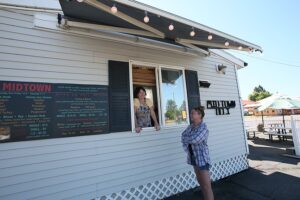
Midtown Drive Up Deli owner Mikele Williams visits with employee Lori Nirk’s daughter, Amanda Flom, before opening for the day. Midtown is in the southeast corner of the My Favorite Things parking lot on Seltice Way in Post Falls. Photo credit: Devin Weeks
Hegsted likens opening a take-out or delivery restaurant through a ghost kitchen to launching a restaurant in an unpopular neighborhood.
“In the beginning, it may be a little more difficult to get people to latch onto the idea of coming to that neighborhood,” he says. “It’s the same with people figuring out the idea that it’s delivery only. But once you get that clientele and build that loyalty, people are willing to get food delivered that they know is going to be good quality.”
Long before the era of COVID-19, Laura Kasbar was a Spokane mother who merely wanted to find a way to address her children’s autism.
Almost by chance, she noticed that video lessons would help, particularly with a child who doctors had declared would never speak.
Nine years later, in 2011, her son Max was mainstreamed, and her Gemiini Systems, still based in Spokane, has become a worldwide leader in online distance learning for people with autism, Down syndrome, dyslexia, speech delay, stroke and other issues.
Since the novel coronavirus outbreak, Gemiini has seen “an avalanche” of interest as families and school districts seek virtual solutions to real-life challenges of learning from home, Kasbar said from her home in Southern California.
The company, with about 50 employees, is run by her son Nicholas out of the Holley- Mason Building in downtown Spokane. After an initial adjustment, Gemiini has adapted to a surge in business.
Gemiini has opened its certification program to professionals and has waived the $490 fee for certification.
Gemiini is also offering schools and clinics the use of its system at no cost as long as they agree to submit the cost of the program to Medicaid.
Gemiini has proven to be a valuable solution for special education administrators, who are struggling to navigate this crisis to continue to meet the needs of special needs students and families.
For many children, “this can be the only link to therapy,” Kasbar said. “And now with COVID everyone is on that boat.
“Our team has been able to get to work immediately. Our subscription base has increased dramatically.”
Gemiini – the unique spelling is Kasbar’s tribute to her autistic twins, Max and Anastasia – was the product of Kasbar’s yearslong search for a solution.

Nicholas Kasbar is ready for a busy day at Gemiini Educational Systems located in the Holley-Mason Building in downtown Spokane. Gemiini Educational Systems, which Kasbar co-founded with his mother Laura, is a video-focused system to teach autistic children. Business is booming for Gemiini since the COVID-19 pandemic sent students home for school.
It was in 2001 that Kasbar recalled walking into a room in her Spokane home, saw all six of her children lined up in front of the television and “couldn’t really tell which were the autistic ones.”
At that time, conventional wisdom dictated the television should be turned off if autistic children were nearby. But that experience told Kasbar video was the answer.
She and her husband Brian had noticed that young Max wouldn’t make eye contact with them but would interact with the television.
“I thought, ‘I’ve got to get my mouth on the TV,’ ” Kasbar said.
That night, they made one-minute videos of a cup and Barney, the TV dinosaur.
“It was a close-up of my mouth saying the word ‘Barney’ next to the actual Barney and then saying the word ‘cup’ next to a cup. We did three sets in a row,” Kasbar said.
That night, after watching several times from his highchair while eating, Max made his biggest breakthrough.
Kasbar held up a cup and he said “cup,” his first word – 3 years and 8 months of age.
During the next decade, and with the help of her oldest son, Nicolas – who also had been on the autism spectrum – Kasbar developed the video program.
In 2012, thanks to funding from the Spokane Angel Alliance and Inland Imaging, Gemiini was launched.
Backed by studies from four universities, Gemiini serves 30,000 clients in 40 countries.
Its use of discrete video modeling, which presents only a specific piece of audio information, was showed by a Portland State University study to be 300% more effective than standard video modeling.
Kasbar was so inspired by the success of her program that she shared her experiences in a book, “Embracing the Battle: Secrets of Victory from a Warrior Mom.”
Closer to home, Gemiini has worked with former NFL star and Spokane native Mark Rypien to develop an application to address suicide prevention.
The goal, Rypien said last fall, is to connect circles of friends of persons at risk so they can better monitor their state of mind.
Lately, the main focus has been reaching children who have been isolated by COVID-19.
“It’s been pretty easy,” said Nicolas, who runs the Spokane headquarters. “After a few headaches, we’ve been able to keep going and helping people, and we’ve updated a lot of our instructions on Facebook Live to walk people through how our lessons work.”
Jim Allen can be reached at (509) 459-5437 or by email at [email protected].
First published in the Journal of Business, June 4, 2020. By Kevin Blocker.
Not even the COVID-19 pandemic has been able to blunt the tide of growth the design-build construction company Verdis is experiencing.
Since becoming a member of the Small Business Administration’s 8(a) Business Development Program in 2016, Verdis has secured 99 federal projects, 19 of which are currently active, says Sandy Young, founder and principal of the Coeur d’Alene-based company.
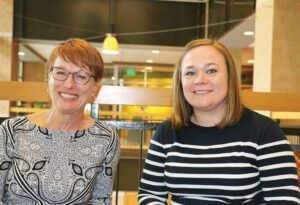
Verdis founder and principal Sandy Young, left, sits with senior planner Stephanie Blalack in the company’s offices in the Parkside Tower, in downtown Coeur d’Alene.
The 8(a) program is a nine-year business development program that provides business training, counseling, marketing, and technical assistance to small businesses that have applied and then been accepted to the program.
Verdis has a greater ability to secure federal work with certifications as both a woman-owned business and an 8(a) operation. The federal government’s goal is to award at least 5% of all federal contracting dollars to small businesses and women- and minority-owned businesses.
Now doing business in 13 western states, Verdis recently secured its largest federal contract to date, an almost $4 million project in Alaska, where Young is from originally.
A 7.1-magnitude earthquake that struck south central Alaska on Nov. 30, 2018, continues to generate engineering and construction repair work through the federal pipeline.
Despite the flourishing federal work, Young says one of the requirements of 8(a) status is to maintain local work in the community. While she declines to disclose the firm’s annual revenue, she says close to a third of all income is generated by local projects.
Deemed as an essential business, Verdis anticipates annual revenue to double in 2020 over 2019. First-quarter revenue alone this year exceeded calendar year 2019, she says.
The company forecasts a nearly four-fold increase in revenue by 2022, compared with 2019 earnings, Young says.
“We’ve been able to self-perform much of our work, which is a big deal for an 8(a),” she says. “Very few firms do both engineering and construction. We seal fish ladders, rip up rails in powerhouses at dams, and restore old buildings and windows.”
With 25 employees, Verdis occupies roughly 2,000-square feet of space in a second-floor suite at Parkside Tower, located at 601 E. Front. It’s the company’s fifth location since its founding in 2007, Young says.
A vice president of construction, Colin Meehan, oversees five project superintendents and six members of a field-personnel team, constituting the firm’s largest concentration of employees.
Young, who is 64, moved to Idaho from Alaska in 1997 and spent the next decade working in Kootenai County’s community development department. Along the way, she met her late husband, Gary, who worked as the director of community development for the city of Post Falls, she says.
The two married in 2006, and the following year, Young says the couple began the process of going into business for themselves.
“He had been in business for himself for a while; he was a licensed landscape architect,” she says. “He’d say, ‘It’s not as easy you think, not every hour is billable.’ I remember sitting on a plane—we were going on a trip somewhere—and telling him, ‘Let’s do it.’’’
In the basement of a building in Post Falls, the couple set up an independent development and planning operation.
“Fortunately, because of our public-sector jobs, people knew us,” she says. “There weren’t many planners around, so we got a few clients right out of the gate.”
Young says the company steadily grew. Landscape architecture work quickly expanded, and Verdis began using subcontractors for civil engineering projects.
In 2012, Verdis was granted woman-owned business status through the SBA, but the business didn’t qualify for the 8(a) program due to the couple’s combined assets, she says.
Then, in 2014, Gary Young contracted cancer and died the following year. It was his death that allowed Verdis to qualify for 8(a) status, she says.
“On his death bed he said, ‘Get the 8(a). I want you to kill it. I don’t want to have to worry about you,’’’ Sandy Young says, fighting back tears.
Reflecting on that time, Young says the business took off as she poured herself into work as way to deal with the grief.
“That wouldn’t have happened if I would’ve had a spouse at home, right?” she asks rhetorically. “Who doesn’t want to be home at night?”
Young says she bought a new car and “hit the road” religiously in an effort to generate new business.
“Honestly, it seemed like such a longshot because you’re sitting there trying to sell your capability, and I really didn’t understand the world I was in,” she says. “We didn’t have any idea how to put a bid together, we didn’t know what we were going to do. We were designers.”
As Young tried to recruit clients, she was asked if Verdis did construction work. Upon answering no, she was met with a consistent message: Come back when you do.
“Three times I heard that. The fourth time I was asked, my answer was, ‘You bet we do,’’’ she says. “I came back and told staff we’re going to figure this out.”
A year later, Verdis secured its first federal contract, a $327,000 Kachess River Bridge project in Cle Elum, Washington, Young says.
Stephanie Blalack, a senior planner with Verdis, has a perspective about Young and the firm, unlike any other employee. She is the company’s first hire.
“I hired Steph out of college (2004) when I still worked for Kootenai County,” Young says. “When I jumped ship, I brought her with me.”
Says Blalack, “She was a phenomenal boss at the county, so when she left in 2007, I was just devastated.”
Seven months later, Young reached out to her with a job offer.
“I was 25, 26, and I’m thinking of leaving my government job? My parents were like, ‘Are you crazy?’’’ says Blalack.
“But I just had this feeling that I knew she was going to make it,” she says. “If it were anybody else, I would not have left my government job.”
Contact author at [email protected] or 509.344.1267
Mark Pond received very few questions from visitors about starting a business at the reference desk when he began a career at the Spokane Public Library in 2006.
“I just sat at the downtown library at the reference desk waiting for business questions to come to me. It was complete radio silence,” said Pond, the library’s business reference librarian. “People didn’t know what the library had to offer. I didn’t know how to market what we had to offer, and the tools we had available weren’t necessarily anything close to the toolbox we have now.”

Pond jumped into action and led an effort to provide resources to entrepreneurs at the Spokane Public Library. By 2016, the library’s business offerings had expanded to include the Level Up Coworking Space at the downtown branch that provides meeting rooms, Macs with Adobe Creative software and access to a Bloomberg Terminal.
The Spokane Public Library is the second in the nation – the New York Public Library being other – with a Bloomberg Terminal, which provides access to financial news, analytics and charts.
In addition to providing one-on-one business consultations and conducting workshops on various business topics at local organizations, Pond maintains resources at spokanebusiness.org that help people research market information, find potential customers, develop business plans and take online job-training courses.
“One of the primary drivers in opening up the Level Up Coworking Space is the gig economy. It gives them tools and resources to figure out how to do their jobs,” Pond said. “Having those kinds of ongoing education and learning opportunities for the Spokane workforce can be huge in terms of business retention and expansion.”
Becoming a business research librarian
Pond, a Kettle Falls native, graduated with a master’s degree in library and information science from the University of Washington in 2000. He worked as a reference assistant at the University of Washington library while attending college. After graduation, Pond was hired as a reference librarian for the Seattle Public Library, a position he held for more than six years.
Pond said he was drawn to library work because of the opportunity to help people with a range of questions and subjects.
“One of the things that appealed to me about the library world is – if you want – you can get super specialized, but sometimes just sitting at the reference desk taking whatever questions coming your way is really fascinating,” he said.
Pond and wife, Maggie, contemplated a move back to Eastern Washington in 2006 to be closer to family and raise their two children. Within hours of discussing the potential move, Pond saw a job posting for a business research position at the Spokane Public Library.
Although Pond had some experience with business research while working at the Seattle Public Library, he was a little concerned at first that the position would be too specialized and might not be a good fit.
“But I love it,” he said, adding it’s a combination of specializing in business topics while also providing the opportunity to answer many different questions from a variety of entrepreneurs.
“At the same time, there’s some common threads in the business research world – who you are selling to and what’s your business model. So those things, (the library) can really help them,” he said. “I enjoy being able to work with a whole span of different businesses around town. I find that really fascinating.”
Growing resources
It took more than a decade for Pond to develop business resources for the downtown library branch. He said the idea to improve the offerings was planted when he met a man who created a device that assists with safety checks for tractor-trailers.
Pond shared with the man some of the library’s business research tools and directories, and compiled a list of trucking companies on the West Coast within seconds.
“The guy said he paid $1,800 for the exact same list two days ago,” Pond said. “So, I had a couple of interactions like that for the tools we have. They are in need and of value to the business community.”
Technology has changed how people access information at the library. More people are gravitating toward digital access to books and reference materials, Pond said.
“I realized it will be a thing of the future and thought, ‘I have to get outside of the library and meet businesses on their own terms,’ ” he said.
After Startup Spokane – a program of Greater Spokane Incorporated – launched in 2015, more entrepreneurs began seeking Pond’s assistance for market research.
About half the businesses Pond works with are startups, and he recently assisted teams of students with business research for the upcoming Northwest Entrepreneur Competition.
“Even today, people don’t realize how incredible the resources and options he’s created for startups and small businesses,” said Mark Gustafson, director of innovation and strategy at Avista Corp. and managing partner of Mind to Market LLC. “For a startup, there’s no way they would have access to this rich of a system in their company.”
Mind to Market LLC is a program by Avista that connects startups with experienced coaches to prepare them for early-stage investments.
Mind to Market participants find business resources – especially PitchBook – useful at the library, Gustafson said.
PitchBook
The Spokane Public Library, with Pond’s help, became the first library in the country to secure a subscription to PitchBook, a venture capital and private equity database.
“Most mom-and-pop businesses in town aren’t looking for venture capital funding, so it doesn’t address them,” Pond said. “But, for the companies that are looking for venture capital funding, it’s really helpful to have the industry standard tool available to them when they come in and consult with me.”
University of Washington’s CoMotion Labs provided grant funds to cover a one-year subscription for PitchBook, totaling more than $18,500 per year.
Pond said the Spokane market and its location in Eastern Washington and proximity to Gonzaga, Whitworth and Washington State universities appealed to PitchBook.
“The universities don’t have a subscription, but I can present it to MBA classes and when they go back to their hometowns, they are aware of PitchBook,” Pond said.
Greater Spokane Incorporated, the Health Sciences & Services Authority of Spokane County and the Spokane Angel Alliance donated more than $13,000 toward a second-year subscription for PitchBook.
“It seems like the library is really well-positioned to be a crowdsourcing hub for access to more resources, even if they might be kind of industry specific, like PitchBook,” Pond said.
A win for the economy
Although the Spokane Public Library’s downtown branch is closed for renovations, Pond is continuing to accept online and phone consultations.
Pond said during the downtown branch closure, the Bloomberg Terminal will be moved to the Spokane Academic Library at the Riverpoint campus.
Prior to Gov. Jay Inslee’s order to restrict gatherings because of the coronavirus pandemic, Pond was holding several meetings at local organizations such as small-business resource SCORE, a volunteer mentorship program, to help people with writing a business plan and other topics.
Pond aims to continue working to provide resources for Spokane businesses and entrepreneurs.
“We are spending $100,000 per year just for business research tools. There’s zero startups anywhere in the nation that are going to spend $100,000 on market research,” he said. “The library can step in and reduce that scope of risk for our local businesses. It’s a win for them and it’s a win for the Spokane economy.”
Among the databases available through the library are:
- Washington State Legal Forms, offering state and federal forms.
- Statista, with market data, market research and market studies.
- Reference USA, with market research, competitive analysis and sales lead generation.
- Microsoft Imagine Academy, with online courses for Microsoft technology.
- Demographics Now, offering demographics, consumer expenditures and interactive maps.
Article first appeared in StrongTowns on March 6 2020. Written by Quint Studer.
I’ve spent the last two years traveling across the country working with small to mid-sized towns on their revitalization efforts. And what I find is they’re getting lots of things right.
Civic-minded entrepreneurs and private citizens have taken the bull by the horns and are working hard to make their communities the best they can be. They’re finding ways to reinvent themselves, attract the right kinds of business, and transform into great places to work, live, and play.
Here are a few strategies community leaders are embracing as they work to create vibrancy:
They’re changing the conversation on who drives revitalization. It’s important to get citizens engaged in change. They (not government) have to lead the way. Leaders are getting people talking about and looking at the community in a new way. How can we develop and sustain communities that serve all of us and satisfy our human desire to be connected, all without putting unfair liabilities on future generations?
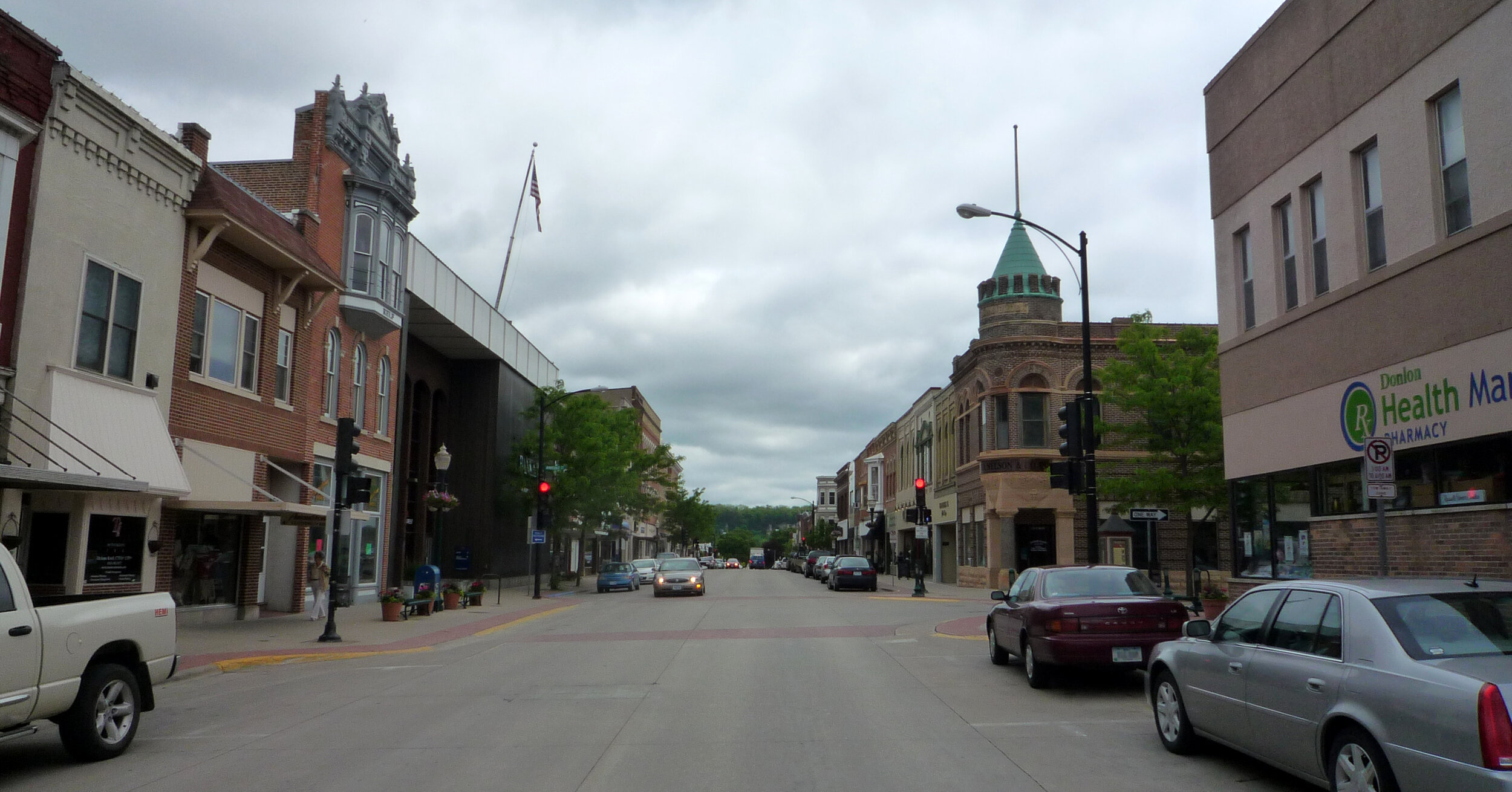
Decorah, Iowa. Image credit.
They’re tying their plans to economic growth. There’s just no other path for long-term job creation and a strong, sustainable tax base. It’s important for a community to know where its revenue comes from and, more importantly, know what isn’t generating revenue. For example, don’t build a beautiful bike path unless you are confident that it’s part of a plan that will ultimately spark economic growth.
They’re getting smart about the psychology of change. It’s only human to resist change, even when we know we need it. Someone is going to object to even the best-laid, most well-thought-out plans. That’s why leaders go into change initiatives expecting barriers and crafting plans to deal with them. The whole community will never get behind anything, so don’t waste energy on trying to convince the unconvinceable.
They’re connecting change initiatives to what citizens care about most. For example, it’s important not just to throw data at people, but rather to find a “burning platform” that speaks to their emotions. People make decisions with their hearts, not minds. You have to connect to something they care about. In Pensacola our burning platform was: What can we do to keep our children and grandchildren from leaving town? Once we framed the issues that way, we were able to get momentum behind the change.
They’re using objective data to drive decisions. Community dashboards keep critical metrics front and center. Just like a company, a community needs objective metrics to know how healthy they are, to identify areas that need improvement, and to gauge progress over time. They need to see all of them together and updated regularly. Think of how the dashboard of a car shows gas, oil, engine performance, temperature, and so forth. It’s a way to constantly be asking, How is our community doing on areas that are important to us? Wages? Crime? Education? High school dropout rate?
They’re rebuilding their downtowns. To attract businesses and talent to a community, it must have a walkable, livable, vibrant downtown with lots of great restaurants, shops, fun activities, and trendy residential areas. Young people, in particular, want to live, work, and play in the same area. When you start by revitalizing your downtown, it gets people activated and sparks growth in the rest of the community.
They’re making education a priority. A strong education system creates a strong talent base and appeals to investors. That’s why leaders are doing everything they can to improve theirs. In 2014 Pensacola had a 66 percent graduation rate and also a 66 percent kindergarten readiness rate. We connected the dots and realized if we focused on early brain development, we could impact graduation rates long-term. So we started a pilot program with local hospitals to work with new mothers. Now we are on track to become America’s first Early Learning City.
They’re getting aggressive about attracting investors. Local, organic investment is great. Leaders do everything they can to find, engage, and attract investors who already live in or have ties to the community. But they also know they need to attract external investors. This is both a science and an art. The “science” part is the dashboard, because it gives investors the metrics they need to know. The “art” part is the compelling story you build around that data: Does your community have a high graduation rate? Are there a lot of Millennials? Is the cost of living affordable? Focus on these selling points.
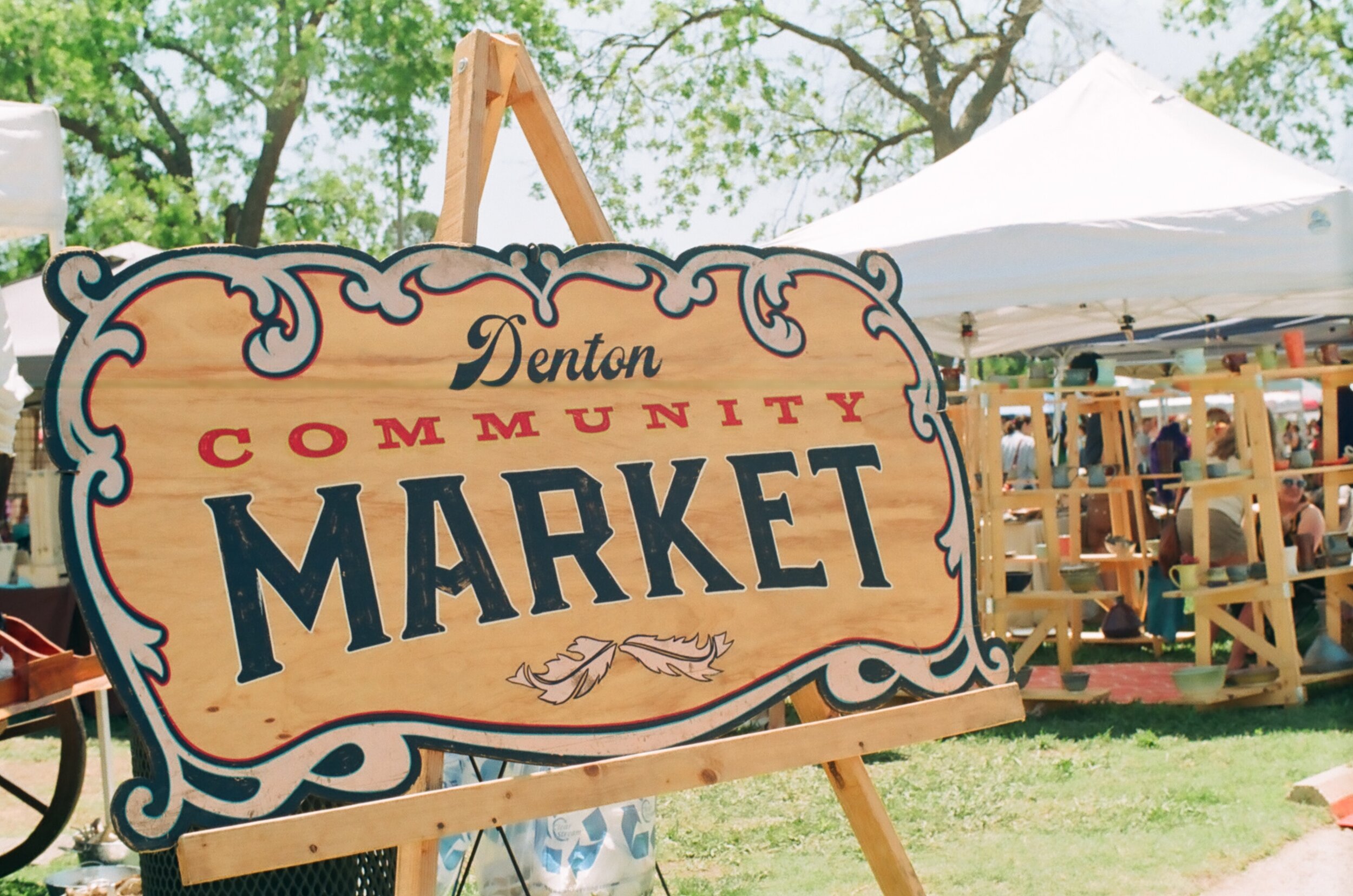
Denton, Texas. Image credit.
They’re managing incentives more thoughtfully. Incentives to attract big businesses tend to be overused. Sometimes they’re a good idea. Sometimes they’re not. It’s crucial for leaders to carefully evaluate these deals before deciding, handle them with transparency and fairness, and insist on clearly defined success metrics. And remember: The best strategy is to create such a dynamic, business-friendly community that incentives won’t be necessary. Businesses will want to come anyway.
They’re partnering with government the right way. More and more, leaders are realizing they shouldn’t depend on local government to drive growth. They likely don’t have the budget, nor are elected officials likely to be around to see long-term development projects through. Private investment must lead the way. Government is a wonderful partner and wants the same outcomes citizens do. Elected officials can focus on keeping the community clean and safe, being consistent and fair with guidelines and zoning rules, and enforcing codes.
They’re going to extraordinary lengths to engage citizens. The more successful leaders are at doing this, the more engaged the community becomes, and the more likely it is to meet its goals. His advice to leaders is to seek citizen feedback on everything. Communicate relentlessly. Connect back to the why behind what you’re doing and how it affects them. Once citizens are galvanized, they will turn out, take action, make their voices heard, and applaud leaders for making the community better.
They’re galvanizing their small business communities in ways that go beyond “business-friendliness.” Community leaders are starting to realize it’s not just about starting businesses, but about keeping them growing. Entrepreneurs rarely start out with a strong grasp of basic business skills. This is why Pensacola holds monthly training and development workshops, small business “roundtables,” and even an annual business conference (EntreCon). Once you galvanize the army of citizens who are business owners, they’ll be your catalysts for change and your sustainers. They’ll keep your growth on track.
They’re leveraging small successes to keep the momentum going. Great leaders never declare victory. The work of creating a vibrant community is never done. Use each success to grow more enthusiasm and grow the project base. Once you start having success, everyone starts feeling good about the community, and it becomes easy to keep the less successful projects from bringing down momentum. Community pride has a huge multiplier effect.
Creating a vibrant community is a journey. It’s not easy. But once you can get some wins under your belt, and get citizens behind you, you’ll start to see what is possible. That’s when the magic happens. When individuals come together with a common goal, it creates a synergy that’s unstoppable. This is how we’ll change America for the better—one community at a time.
Featured image via Unsplash.
About the Author
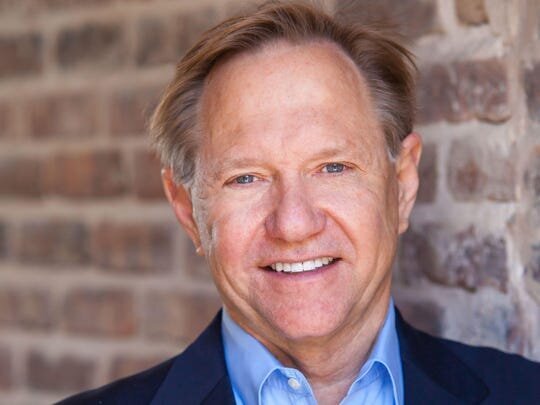
Quint Studer is author of Building a Vibrant Community: How Citizen-Powered Change Is Reshaping America and Wall Street Journal bestseller The Busy Leader’s Handbook: How to Lead People and Places That Thrive. He is founder of Pensacola’s Studer Community Institute, a nonprofit organization focused on improving the community’s quality of life, and Vibrant Community Partners, which coaches communities in building out a blueprint for achieving growth and excellence. Quint speaks and works with communities across the country, helping them execute on their strategic plans, create a better quality of life, and attract and retain talent and investment. He is a businessman, a visionary, an entrepreneur, and a mentor to many. He currently serves as Entrepreneur-in-Residence at the University of West Florida, Executive-in-Residence at George Washington University, and Lecturer at Cornell University.
For more information, please visit www.thebusyleadershandbook.com, www.vibrantcommunityblueprint.com, and www.studeri.org.
Date: March 24, 2020
Time: 9:00am-2:15pm (8:30am – Networking Breakfast)
Location: CenterPlace Regional Event Center
2426 North Discovery Place
Spokane Valley, WA. 99216
Click Here for Online Registration »
Meeting Agenda and Mail-In Registration Form Click Here »
Opportunity Zones are a community development program established by Congress in 2017 to encourage long-term investments in low-income urban and rural communities. Private investment vehicles that place 90% or more of their funds into an Opportunity Zone can earn tax relief on the capital gains generated through those investments. Tax benefits increase the longer investments are in place.
An Opportunity Zone is a community nominated by the state and certified by the Treasury Department as qualifying for this program. See which communities are certified by looking at this interactive map.
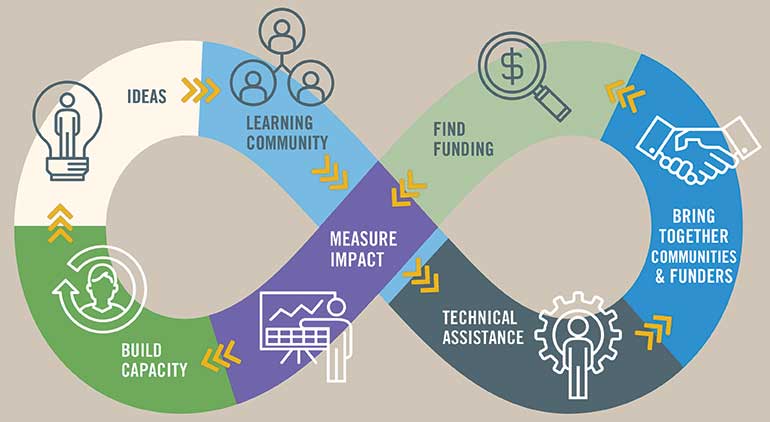
For specific information on Opportunity Zones in Idaho, click here.
For specific information on Opportunity Zones in Washington, click here.
Colfax-based Nanotechnology Company Challenged By U.S. Air Force to Raise $1.5 Million to Help Crowdfund Military Research
COLFAX – A local Colfax based tribology company is set to receive a $1.5 million dollar grant from the U.S. Air Force, if it can raise the matching funds in time.
TriboTEX technology has won numerous awards, and obtained funding from a variety of institutions, including the National Science Foundation, the Department of Energy, and NASA.
To date, the company has sold over 36,000 units worldwide. They have a range of products suitable for the smallest lawn mower engines to the largest semi truck engines.
TriboTEX applied for a Small Business Innovation Research program through AFWERX, in order to obtain access to the defense market. AFWERX is a United States Air Force program with the goal of fostering a culture of innovation within the service. Encompassing a number of programs supported with relatively small amounts of funding, the initiative is intended to circumvent bureaucracy and engage new entrepreneurs in Air Force programs.
The U.S. Air Force has challenged the TriboTEX team to raise up to $1.5 million for matched funding, which is necessary to scale the business operation and produce more products for military testing. TriboTEX is working with AFWERX to test TriboTEX products in military equipment. The TriboTEX team plans to raise the money necessary to fulfill their grant requirements through crowdfunding, by launching a Kickstarter campaign that went live today, for the company’s latest nanotechnology product, “TriboTEX Transmission.”
TriboTEX Transmission uses the familiar two-sided nanoparticles specifically designed for automatic transmissions. The nanoparticles reduce friction, which prevent accelerated wear, lower temperature and noise, and extend the life of the transmission. Transmissions with TriboTEX will last longer, potentially saving thousands in expensive repairs.
Currently, the Department of Defense spends millions of taxpayer dollars in maintenance costs. TriboTEX is aiming to save Americans millions by preserving equipment used by the military. “Helicopter gear boxes are limited in flight time, and longevity is critical for safety of the flight,” stressed CTO Rudenko, who says the product will work for anyone who wants to improve the functionality of their transmission, whether its a 2002 Toyota Prius or a Sikorsky UH-60 Black Hawk helicopter.
